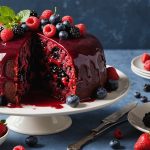Understanding the Cottage Pie Crust
In English cuisine, the cottage pie holds historical significance, particularly due to its comforting association with frugality and resourcefulness. The crust, serving as an essential feature of this dish, embodies traditional values through its simple yet effective composition. When discussing crust techniques, it’s vital to recognize the foundation laid by traditional ingredients. These typically include a mix of mashed potatoes, lending a hearty and nourishing topping to the savoury filling beneath.
Moreover, cultural variations in crust preparation emphasize the adaptability of cottage pie across different regions. For instance, some recipes integrate cheese into the potato topping, providing a richer flavour and golden finish. Within these variations, certain crust techniques stand out—each adding a unique twist on tradition. Such diversity reflects not only culinary preferences but also local ingredient availability.
Also read : Unlock the Secrets to Perfect English Summer Pudding Bursting with Fresh Berries
This versatile approach to crust-making in English cuisine allows for creativity while maintaining heritage. As you explore these techniques, you’ll find that slight tweaks can elevate the texture and taste remarkably. Whether adhering to strict tradition or experimenting with new ideas, the cottage pie crust remains a cornerstone of comforting home cooking.
Essential Ingredients for the Perfect Crust
Creating the perfect pie crust requires a focus on high-quality ingredients. Types of flour play a pivotal role in crust texture. Opting for all-purpose flour is common; however, using pastry or cake flour can also yield a tender crust. Each type offers different results in terms of texture and tenderness.
Also to read : Unlock Culinary Excellence: Shaping Tomorrow’s Food Industry Today
The choice of fat—typically between butter and shortening—greatly influences flavour and texture. Butter is known for its rich taste, while shortening often provides a flakier crust. A combination of both can sometimes offer the best of both worlds: flavourful and flaky.
Water is another critical component. It affects the dough’s texture significantly. Cold water prevents the fat from melting too quickly during mixing, which is essential for achieving a light crust.
Balance in these elements can transform a basic crust into something extraordinary. Careful consideration of each ingredient will help you achieve a crust that not only complements but enhances your pie. Understanding these nuances equips bakers with the knowledge needed for crust-making success.
Step-by-Step Instructions for Crafting the Crust
Embarking on the journey of creating a perfect pie crust involves mastering essential baking techniques. Each step matters, from the preparation of ingredients to the final bake.
Preparation of Ingredients
Before anything else, ensure your ingredients are cold. Butter should be chilled but pliable, ensuring it integrates seamlessly when mixed. Similarly, cold water is necessary to prevent premature melting, which can compromise the texture of the dough.
Mixing Techniques
Begin by gently cutting the butter into your chosen flour until a coarse crumb forms. This process, known as “rubbing in,” is crucial for achieving flakiness. Add small amounts of water gradually, mixing lightly to bind the dough without losing its crumbly quality. Here, patience is key; over-mixing can result in a dense crust, so aim for just-combined dough.
Rolling and Shaping the Crust
With ingredients prepared, chill the dough to solidify the fat and make it easier to handle. Once chilled, roll out the dough to about 1/8 inch thickness, ensuring even distribution. Use light flour dusting to prevent sticking, and take care in using the correct pie dish for the best results.
Tips for Achieving the Right Texture and Flavor
Attaining the perfect crust texture and flavour requires a thoughtful approach to pie-making. One essential technique is achieving flakiness, typically through the meticulous incorporation of fat. Opt for cold, cubed butter, cutting it into flour until you reach pea-sized pieces. This method facilitates steam pockets during baking, yielding a light and flaky crust.
Balance is crucial when seasoning a crust. A subtle infusion of salt enhances the natural flavours without overpowering them. For those seeking a bolder taste, experiment by incorporating herbs and spices. Thyme or rosemary can offer aromatic notes, complementing the rich savouriness of the filling beneath.
Additionally, consider the nuances of flavour enhancement through creativity. Varying your approach with herbs like sage or incorporating pepper can add depth to your crust. These adjustments do not only please the palate but also showcase your culinary flair.
Ultimately, achieving the perfect texture and flavour is a blend of tradition and innovation. Experimenting with these elements will help you craft a pie crust that’s both unique and anchored in classic techniques.
Common Mistakes to Avoid
Embarking on the journey of creating the perfect pie can sometimes lead to common baking pitfalls. Understanding these missteps is vital for achieving culinary success.
One frequent error is overworking the dough. This happens when the dough is mixed excessively, leading to a tough crust. The key is to blend ingredients until just combined, maintaining a light touch. Overworking can activate gluten too much, resulting in less tenderness.
Another crucial aspect to be mindful of is improper baking temperatures. If the oven is not at the correct temperature, it can affect the crust’s texture. An oven thermometer can ensure precision, helping uphold ideal conditions for a golden, flaky crust.
Moreover, skipping blind baking when necessary can be detrimental. Blind baking involves pre-baking the crust, a step particularly essential for custard or cream fillings. This prevents a soggy bottom, ensuring structural integrity.
Overlooking these crust issues can compromise your pie, so attention to detail is essential. By being vigilant and adhering to these recommendations, you can avoid these pitfalls and craft a superior crust that complements your filling perfectly.
Recipe Variations for Cottage Pie Crust
Exploring cottage pie variations allows for creativity, particularly in crafting inventive crusts. There is a wealth of options to modify the traditional pie to cater to diverse preferences and dietary needs.
Alternative Flours
Incorporating alternative flours like almond or whole wheat can yield intriguing textures and flavours. Almond flour, though more delicate, provides a slightly nutty taste and is ideal for those avoiding gluten. Whole wheat flour offers a denser crust with a robust flavour, suited for those seeking more fibre.
Incorporating Vegetables
Vegetables like parsnip or sweet potato can be mixed into the potato topping for added nutrition and unique taste. For instance, incorporating mashed sweet potato can add a touch of sweetness and vibrant colour to your crust.
Gluten-Free Options
For those requiring gluten-free adjustments, consider using gluten-free flour blends specifically designed for baking. Options such as rice flour or cornstarch provide suitable alternatives, ensuring everyone can enjoy this classic dish without sacrificing flavour or texture.
Ultimately, each variation offers its own pros and cons, inviting home cooks to experiment with pairings that best complement their savoury fillings. This approach enhances culinary diversity while maintaining the dish’s comforting essence.
Visual Aids and Their Importance
The use of visual baking guides in cooking not only enhances understanding but also boosts confidence in bakers of all levels. By providing instructional images or videos, these guides help illustrate each step of the pie crust-making process, ensuring clarity. For example, seeing the correct consistency of dough through an image can prevent common errors such as overmixing.
Incorporating visuals aids precision and allows bakers to compare their efforts to ideal examples. This not only enhances technique but also helps to ensure that final results meet expectations. Baking can be an intimidating endeavor, especially for beginners, and visual aids can demystify complex techniques, like achieving the perfect dough thickness or the golden finish of a crust.
Furthermore, interactive content such as step-by-step videos or even live streaming sessions offer real-time guidance, encouraging viewer interaction. This engagement can help address specific questions, creating a dynamic learning environment. By combining concise instructions with robust visual aids, bakers can feel encouraged to explore and refine their skills, enhancing their overall culinary confidence.
Conclusion: The Significance of a Perfect Crust
In English cuisine, mastering essential culinary techniques for crafting a pie crust is crucial to achieving an exceptional dish. A well-prepared crust can transform a pie, enhancing flavours and textures, and ultimately elevating the entire dining experience.
A meticulously crafted crust impacts the dish immensely, marrying perfectly with the filling and adding both structural and taste value. Attention to detail in ingredients and preparation significantly influences the pie’s quality. From the choice of flour and fat to precise baking temperatures and advisable chilling, each step contributes integral characteristics to the final product.
An extraordinary pie crust does more than just cover the pie—it sets the tone for the entire dish, offering a delightful interplay between crispness and tenderness. Encouraging experimentation with personal touches, like varying herbs, spices, or alternative flours, invites creativity and customization in pie-making.
Achieving a perfect crust symbolizes not merely a recipe’s success but also an understanding and appreciation of tradition, innovation, and individual expression in the culinary arts. With thoughtful preparation, a perfect crust can become a signature element of any pie, embodying both skill and personal flair.











